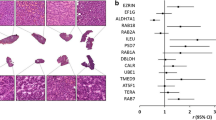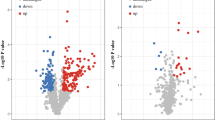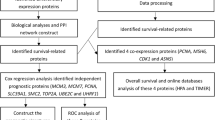Abstract
Purpose
The comparative study of differentially expression of protein profiles of hepatocellular carcinoma cell lines with various metastasic potential and screening key molecules related to hepatocellular carcinoma metastasis and recurrence.
Methods
Using two-dimensional electrophoresis and liquid chromatography-electrospray ionization-tandem mass spectrometry (LC-ESI-MS/MS), we analyzed differentially displayed proteomics of human hepatocellular carcinoma cell lines Hep3B, MHCC97L, MHCC97H with different metastasic potential.
Results
Approximate 1,000 protein spots were detected on silver-stained gel by ImageMaster (977±113 spots in Hep3B, 1092±40 in MHCC97L, and 889±14 in MHCC97H). Fifty distinct different protein spots were analyzed with online LC-ESI-MS/MS. Only 26 protein spots had a positive result, including annexin1, S100A4, and so on. In comparison with nonmetastasis Hep3B cell lines, there were 16 proteins overexpressed in MHCC97H and MHCC97L, 10 proteins underexpressed in MHCC97H and MHCC97L. Applying cell immunohistochemistry and RT-PCR, we further validated two interesting and different proteins, annexin1 and S100A4.
Conclusion
The protein profile of metastatic hepatocellular carcinoma cell lines displayed obvious differences compared with non-metastatic liver cancer cell lines. The results imply that various different proteins may lead to HCC metastasis together.





Similar content being viewed by others
Abbreviations
- HCC:
-
Hepatocellular carcinoma
- IPG-DALT:
-
Immobilized pH gradient-Dalton
- 2-DE:
-
Two-dimensional electrophoresis
- LC-ESI-MS/MS:
-
Liquid chromatography-electrospray ionization-tandem mass spectrometry
- RT-PCR:
-
Reverse transcription polymerase chain reaction
- DMEM:
-
Dulbecco’s modified Eagle medium
- CBB:
-
Coomassie brilliant blue
- HPLC:
-
High performance liquid chromatography
- PBS:
-
Phosphate buffered saline
- BCIP/NBT:
-
5-bromo-4-chloro-3-indodyl phosphate /nitroblue tetrazolium
- rARLP-1:
-
Rat aldose reductase-like protein1
- Rak-C:
-
Rat aldo-keto reductase protein-C
References
Brunagel G, Schoen RE, Bauer AJ, Vietmeier BN, Getzenberg RH (2002) Nuclear matrix protein alterations associated with colon cancer metastasis to the liver. Clin Cancer Res 8:3039–3045
Coffey DS(2002) Nuclear matrix proteins as proteomic marks of preneoplastic and cancer lesions. Clin Cancer Res 8:3031–3033
Hanazaki K, Kajikawa S, Shimozawa N, Mihara M, Shimada K, Hiraguri M, Koide N, Adachi W, Amano J (2000) Survival and recurrence after hepatic resection of 386 consecutive patients with hepatocellular carcinoma. J Am Coll Surg 191:381–388
Komatsu K, Kobune-Fujiwara Y, Andoh A, Ishiguro S, Hunai H, Suzuki N, Kameyama M, Murata K, Miyoshi J, Akedo H, Tatsuta M, Nakamura H (2000) Increased expression of S100A6 at the invading fronts of the primary lesion and liver metastasis in patients with colorectal adenocarcinoma. Br J Cancer 83:769–774
Li Y, Tang ZY, Ye SL, Liu YK, Chen J, Xue Q, Chen J, Gao DM, Bao WH (2001) Establishment of cell clones with different metastatic potential from the metastatic hepatocellular carcinoma cell line MHCC97. World J Gastroenterol 7:630–636
Masaki T, Tokuda M, Ohnishi M, Watanabe S, Fujimura T, Miyamoto K, Itano T, Matsui H, Arima K, Shirai M, Maeba T, Sogawa K, Konishi R, Taniguchi K, Hatanaka Y, Hatase O, Nishioka M (1996) Enhanced expression of protein kinase substrate annexin1 in human hepatocellular carcinoma. Hepatology 24:72–81
Nakamura T, Ajiki T, Murao S, Kamigaki T, Maeda S, Ku Y, Kuroda Y (2002) Prognostic significance of S100A4 expression in gallbladder cancer. Int J Oncol 20:937–941
Pedersen KB, Nesland JM, Fodstad, Malandsmo GM (2002) Expression of S100A4, E-Cadherin, α- and β-catenin in breast cancer biopsies. Br J Cancer 87:1281–1286
Soskic V, Gorlach M, Poznanovic S, Boehmer FD, Godovac-Zimmermann J (1999) Functional proteomics analysis of signal transduction pathways of the platelet-derived growth factor βreceptor. Biochemistry 38:1757–1764
Steiner S, Witzmann FA (2000) Proteomics: application and opportunities in preclinical drug development. Electrophoresis 21:2099–2104
Tang ZY(2000) Surgery of hepatocellular carcinoma with special reference to studies on metastasis and recurrence. Gastroenterol Today 4:191–195
Tang ZY(2003). Overview. In: Tang ZY (ed) Metastasis and recurrence of hepatocellular carcinoma basic and clinical studies. Shanghai Science and Technology, Shanghai, pp 1–24
Tang ZY, Yu YQ, Zhou XD, Ma ZC, Wu ZQ (1998) Progress and prospects in hepatocellular carcinoma surgery. Ann Chir 52:558–563
Tang ZY, Zhou XD, Li ZY, Yang BH, Ma ZC, Ye SL, Wu ZQ, Fan J, Liu YK, Liu KD, Qin LX, Tian J, Sun HC, He B, Xia JL, Qiu SJ, Zhou J (1999) Surgical treatment of hepatocellular carcinoma and related basic research with special reference to recurrence and metastasis. Chin Med J 112:887–891
Tian J, Tang ZY, Ye SL, Liu YK, Lin ZY, Chen J, Xue Q (1999) New human hepatocellular carcinoma (HCC) cell line with highly metastatic potential (MHCC97) and its expressions of the factors associated with metastasis. Br J Cancer 81:814–821
Timperman AT, Aebersold R (2000) Peptide electroextraction for direct coupling of in gel digests with capillary LC-MS/MS for protein identification and sequencing. Anal Chem 72:4115–4121
Wu WG, Tang XM, Hu W, Lotan R, Hong EK, Mao L (2002) Identification and validation of metastasis-associated protein in head and neck cancer cell line by two-dimensional electrophoresis and mass spectrometry. Clin Exp Metastasis 19:319–326
Yu LR, Zeng R, Shao XX, Wang N, Xu YH, Xia QC (2000) Identification of differentially expressed proteins between human hepatoma and normal liver cell lines by two-dimensional electrophoresis and liquid chromatography-ion trap mass spectrometry. Electrophoresis 21:3058–3068
Zeindl-Eberhart E, Klugbauer S, Dimitrijevic N, Jungblut PR, Lamer S, Rabes HM (2001) Proteome analysis of rat hepatomas: carcinogen-dependent tumor-associated protein variants. Electrophoresis 22:3009–3018
Acknowledgements
This research was supported by the National Basic Research Priorities programme (001CB510205) and Nation Nature Science Foundation(30170416)
Author information
Authors and Affiliations
Corresponding author
Rights and permissions
About this article
Cite this article
Cui, JF., Liu, YK., Pan, BS. et al. Differential proteomic analysis of human hepatocellular carcinoma cell line metastasis-associated proteins. J Cancer Res Clin Oncol 130, 615–622 (2004). https://doi.org/10.1007/s00432-004-0576-5
Received:
Accepted:
Published:
Issue Date:
DOI: https://doi.org/10.1007/s00432-004-0576-5




